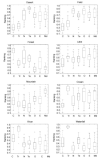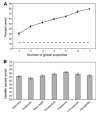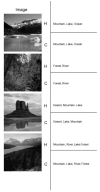Recognition of natural scenes from global properties: seeing the forest without representing the trees
- PMID: 18762289
- PMCID: PMC2759758
- DOI: 10.1016/j.cogpsych.2008.06.001
Recognition of natural scenes from global properties: seeing the forest without representing the trees
Abstract
Human observers are able to rapidly and accurately categorize natural scenes, but the representation mediating this feat is still unknown. Here we propose a framework of rapid scene categorization that does not segment a scene into objects and instead uses a vocabulary of global, ecological properties that describe spatial and functional aspects of scene space (such as navigability or mean depth). In Experiment 1, we obtained ground truth rankings on global properties for use in Experiments 2-4. To what extent do human observers use global property information when rapidly categorizing natural scenes? In Experiment 2, we found that global property resemblance was a strong predictor of both false alarm rates and reaction times in a rapid scene categorization experiment. To what extent is global property information alone a sufficient predictor of rapid natural scene categorization? In Experiment 3, we found that the performance of a classifier representing only these properties is indistinguishable from human performance in a rapid scene categorization task in terms of both accuracy and false alarms. To what extent is this high predictability unique to a global property representation? In Experiment 4, we compared two models that represent scene object information to human categorization performance and found that these models had lower fidelity at representing the patterns of performance than the global property model. These results provide support for the hypothesis that rapid categorization of natural scenes may not be mediated primarily though objects and parts, but also through global properties of structure and affordance.
Figures










Similar articles
-
Nonaccidental properties underlie human categorization of complex natural scenes.Psychol Sci. 2014 Apr;25(4):851-60. doi: 10.1177/0956797613512662. Epub 2014 Jan 28. Psychol Sci. 2014. PMID: 24474725 Free PMC article.
-
Modeling categorization of scenes containing consistent versus inconsistent objects.J Vis. 2010 Mar 26;10(3):11.1-11. doi: 10.1167/10.3.11. J Vis. 2010. PMID: 20377288
-
What makes a scene? Fast scene categorization as a function of global scene information at different resolutions.J Exp Psychol Hum Percept Perform. 2022 Aug;48(8):871-888. doi: 10.1037/xhp0001020. Epub 2022 Jun 16. J Exp Psychol Hum Percept Perform. 2022. PMID: 35708933
-
Evidence for participation by object-selective visual cortex in scene category judgments.J Vis. 2014 Aug 21;14(9):19. doi: 10.1167/14.9.19. J Vis. 2014. PMID: 25146577
-
Building the gist of a scene: the role of global image features in recognition.Prog Brain Res. 2006;155:23-36. doi: 10.1016/S0079-6123(06)55002-2. Prog Brain Res. 2006. PMID: 17027377 Review.
Cited by
-
Associative Processing Is Inherent in Scene Perception.PLoS One. 2015 Jun 12;10(6):e0128840. doi: 10.1371/journal.pone.0128840. eCollection 2015. PLoS One. 2015. PMID: 26070142 Free PMC article.
-
Concepts, contents, and consciousness.Neurosci Conscious. 2016 Jan;2016(1):niv012. doi: 10.1093/nc/niv012. Epub 2016 Mar 5. Neurosci Conscious. 2016. PMID: 30135743 Free PMC article.
-
Extrapolating spatial layout in scene representations.Mem Cognit. 2010 Dec;38(8):1018-25. doi: 10.3758/MC.38.8.1018. Mem Cognit. 2010. PMID: 21156866
-
Coherent natural scene structure facilitates the extraction of task-relevant object information in visual cortex.Neuroimage. 2021 Oct 15;240:118365. doi: 10.1016/j.neuroimage.2021.118365. Epub 2021 Jul 4. Neuroimage. 2021. PMID: 34233220 Free PMC article.
-
A data driven approach to understanding the organization of high-level visual cortex.Sci Rep. 2017 Jun 15;7(1):3596. doi: 10.1038/s41598-017-03974-5. Sci Rep. 2017. PMID: 28620238 Free PMC article.
References
-
- Appelton J. The experience of landscape. Wiley; London: 1975.
-
- Ariely D. Seeing sets: Representation by statistical properties. Psychological Science. 2001;12:157–162. - PubMed
-
- Ashby F, Lee W. Predicting similarity and categorization from identification. Journal of Experimental Psychology: General. 1991;120(2):150–172. - PubMed
-
- Bar M. Visual objects in context. Nature Reviews: Neuroscience. 2004;5:617–629. - PubMed
Publication types
MeSH terms
Grants and funding
LinkOut - more resources
Full Text Sources

